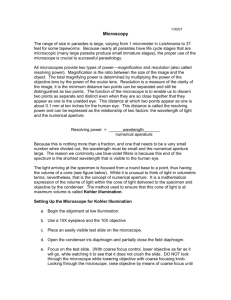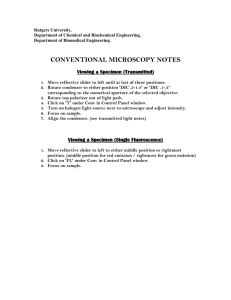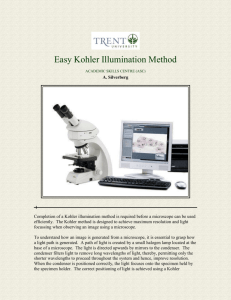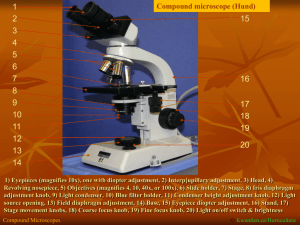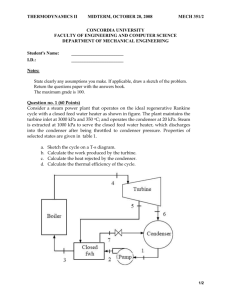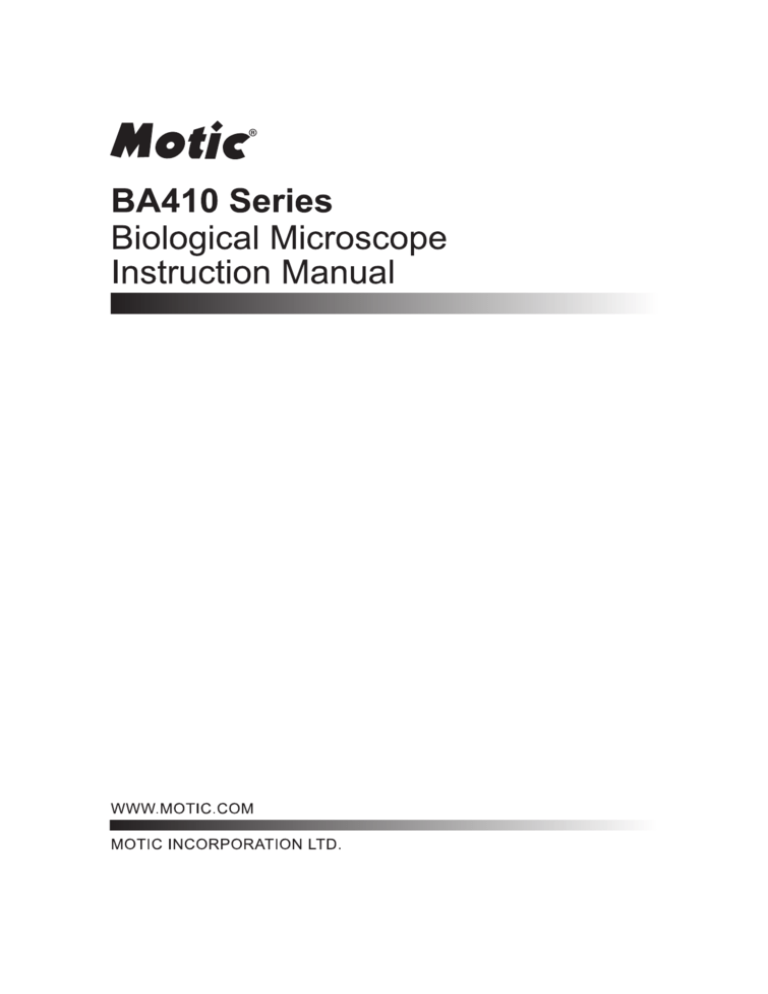
We are constantly endeavouring to improve our instruments and to adapt them to the
requirements of modern research techniques and testing methods. This involves
modification to the mechanical structure and optical design of our instruments.
Therefore, all descriptions and illustrations in this instruction manual, including all
specifications are subject to change without notice.
1
INFINITY CORRECTED OPTICS
In this optical concept the light beams are parallel after leaving the objective in the
direction of the eyepieces. A second optical element, the tube lens (normally located in
the eyepiece tube) is used to converge the parallel beams, resulting in an intermediate
image. The intermediate image is focussed by the eyepieces, to provide the real image
for visual observation.
The implementation of a tube lens gives the opportunity to minimize chromatic
aberrations and other “optical defects”. Further, in “Infinity Optics” the distance between
the objective and tube lens is not as strictly fixed as in the (historically older) “Finite
Optics” of 160mm tube length.
This allows additional optical components to be inserted between the objective and tube
head.
Fluorescence attachments, discussion bridges, eye level risers and other options can be
added without affecting the image quality.
In general “Infinity Optics” provides flexibility and the opportunity to add additional
optional features.
2
TABLE OF CONTENTS
Section
I
Nomenclature
4
II
Setting up the instrument
7
Operating environment
7
Assembling the microscope
7
Verifying Input voltage
7
1 Mechanical stage
8
2 Specimen holder
8
3 Objectives
8
4 Condenser
9
5 Eyepiece tube
9
6 Eyepieces
10
7 Illumination
10
8 Filters
11
9 Power cord
12
III
IV Microscopy
V
12
1 Coarse and fine focusing
12
2 Coarse focus torque adjustment
12
3 Coarse focus quick stop
13
4 Stage upper limit stop adjustment
13
5 Beam splitter lever
14
6 Interpupillary distance adjustment
15
7 Diopter adjustment
15
8 Centering the condenser
16
9 Use of aperture diaphragm
17
10 Use of field diaphragm
18
11 Brightness and contrast adjustment
18
Photomicrographic procedure
19
VI Using Oil Immersion Objectives
20
VII Troubleshooting Table
21
VIII Care and maintenance
23
IX Warning label
26
3
I. Nomenclature
MOTIC BA410 (30W Halogen)
4
MOTIC BA410 (Trinocular) 30W Halogen
5
MOTIC BA410 30W Halogen
6
II. Setting up the instrument
Avoid placing the instrument in locations exposed to direct sunlight, dust, vibration, high
temperature, high humidity and where it is difficult to unplug the power supply cord.
Operating environment
y
Indoor use
y
Altitude: Max 2000 meters
y
Ambient temperature: 15°C to 35°C
y
Maximum relative humidity: 75% for temperature up to 31ºC decreasing linearly to
50% relative humidity at 40ºC
y
Supply voltage fluctuations: Not to exceed ±10% of the normal voltage
y
Pollution degree: 2 (in according with IEC60664)
y
Installation / Overvoltage category: 2 (in according with IEC60664)
y
Air Pressure of 75kPa to 106kPa
y
Avoid frost, dew, percolating water, and rain
III. Assembling the microscope
Verifying Input voltage
y
The automatic voltage selection works with a broad range of settings. However,
always use a power cord that is rated for the voltage used in your area and that has
been approved to meet local safety standards. Using the wrong power cord could
cause fire or equipment damage.
y
If using an extension cord, use only a power supply cord with a protective earth (PE)
wire.
y
In order to prevent electric shock, always turn the power supply off before connecting
the power cord.
7
y
Electrical Specifications:
30W Halogen Bulb
Input: 90-240V~, 80VA, 50-60Hz
Bulb: 6V
30W Halogen
Fuse: 250V T2.5A (If the original fuse is blown, please replace with specified fuse)
1. Mechanical stage
y
Loosen the stage clamp screw; fit the stage into the circular dovetail mount. An
orientation notch at the back of the stage has to fit to an orientation pin at the stage
carrier. Tighten with the clamp screw facing forward.
y
Torque adjustment
The torque of the y-axis and x-axis travel knobs can be adjusted by torque
adjusting knobs.
For y-axis to (+) increase or (-) decrease the torque, turn Knob Y while holding A
For x-axis to (+) increase or (-) decrease the torque, turn Knob X while holding B
2. Specimen holder
y
Attach the specimen holder, using the two mounting holes. If the stage is to be used
with right right-hand controls, attach the specimen holder to the left-hand holes and
similarly, with left-hand controls to the right-hand holes.
3. Objectives
y
Lower the stage completely. Screw the objectives into the revolving nosepiece so
that clockwise rotation of the nosepiece brings the next higher magnification objective
into position.
8
4. Condenser
y
Raise the stage by turning the coarse focus knob.
y
Completely lower the condenser carrier by turning the condenser focus knob.
y
Insert the condenser into the dovetail mount with aperture scale facing forward
towards the user. Secure it with the condenser clamp screw.
y
Turn the condenser focus knob to raise the condenser as far as it will go.
1. Condenser focus knob
5. Eyepiece tube
Loosen the eyepiece tube clamp screw. Insert the round dovetail mount on the
eyepiece tube into the round dovetail mount on the microscope arm. Tighten the
eyepiece tube clamp screw to secure the eyepiece tube in place.
1. Eyepiece Tube Clamp Screw
9
6. Eyepieces
y
Use the same magnification eyepieces for both the eyes.
y
Inserting or removing the eyepieces is facilitated by twisting the eyepieces when
pushing in or pulling out.
7. Illumination
y
The quartz halogen bulb, used as a light source, has higher luminance and color
temperature than conventional tungsten bulb. The luminance is approximately four
times greater.
y
As long as the bulb voltage is kept constant, the halogen bulb maintains the same
level of brightness and color temperature regardless of whether it is new or nearing
the end of its life.
10
8. Filters
y
Remove the collector cover and place the filter in the filter holder located around the
field lens, screw the collector cover, taking care that dust, dirt and fingerprints do not
get on the filter and the field lens.
1. Collector Cover
y
Filter selection:
Filter
ND2 (T=50%)
Blue filter (colour balance filter)
Green interference (546nm)
HE (didymium filter)
y
Function
For brightness adjustment in
photomicrography
For routine microscopy and
photomicrography
For phase contrast and contrast
adjustment with black and white film
For colour photomicrography of HE
stained specimen with tungsten type film
Diffuser
The lamp is pre-centred and pre-focused, saving the inconvenience of having to
make these adjustments.
The illuminating system has two plastic disks enclosed in a dustproof covering
between the collector lens and field lens, which modify the light passing through them.
One disc contains very small diameter lenses of identical curvature aligned to
efficiently enlarge the light source image at the condenser aperture. The second disc
is a minimum diffusion lemon skin filter that is used to eliminate the haze and
inference colours caused by the high uniformity of the first filter.
11
9. Power cord
Connect the socket of the of the power cord to the AC inlet on the rear of the base of
the microscope. Plug in the other end of the cord to an AC outlet with ground
conductor.
IV. Microscopy
1. Coarse and fine focusing
y
Focusing is carried out with the coarse and fine focus knobs at the left and right of the
microscope stand.
y
The direction of vertical movement of the stage corresponds to the turning direction of
the focus knobs.
y
One rotation of the fine focus knob moves the stage 0.1mm. The graduation on the
fine focus knob is 1 micron.
Never attempt either of the following actions, since doing so will damage the
focusing mechanism:
y
Rotate
y
Turning
the left and right knob while holding the other.
the coarse and fine focus knobs further than their limit.
2. Coarse focus torque adjustment
To increase the torque, turn the torque adjustment ring located behind the left-hand
coarse focus knob in the direction indicated by the arrow. To reduce the torque, turn
the ring in the direction opposite to that indicated by the arrow.
1.) Fine Focus Knob
2.) Coarse Focus Knob
3.) Coarse Focus Torque Adjustment Ring
12
3. Coarse Focus Quick Stop
y
The coarse focus height stop serves as a quick accessible possibility for the user to
limit the upper focus position in order to prevent a collision of the Objective with the
specimen.
y
Focus on the specimen using the lowest power objective and the coarse focus knob.
Rotate the highest power objective into place. Carefully turn the coarse focus knob
raising the specimen until it is just out of focus, but the slide cover slip does not touch
the highest power objective.
Simply turn the lever in clockwise direction as shown in the picture below and lock the
actual position as upper limit.
y
To loosen the upper limit, just turn the lever in the opposite direction
1. Coarse Focus Quick Stop
4. Stage Upper Limit Stop adjustment:
(Upper Stage Limit is preset at the factory; please only adjust if necessary)
y
The Stage Upper Limit stop marks the stage position at which the specimen is in
focus i.e. by restricting the movement of the coarse focus knob.
y
With the specimen in focus, turn the stage upper limit stop knurled ring clockwise
until it reaches the stop.
y
When the stage upper limit stop is in position, the stage cannot be raised from that
position.
However, the fine focus knob can move the stage regardless of the limit but will only
lower the stage.
y
Lower the stage by using the coarse focus knob anticlockwise
13
1. Stage Upper Limit Stop
5. Beam Splitter Lever
y
When the slider is pushed in, 100% of the light will enter the eyepieces. When pulled
out, the light beam will be divided as follows:
y
20:80 (visual: photo; standard tube)
0:100 (visual: photo; tube for low light situations, optional tube)
y
The triple position tube (optional) is the most flexible tube by giving 2 photo positions:
y
20:80 (visual: photo; for simultaneous observation by eyepiece and camera)
0:100 (visual: photo; for low light situations, e.g. fluorescence)
1. Beam Splitter Lever
14
6. Interpupillary distance adjustment
y
Before adjusting the interpupillary distance, bring a specimen into focus using the 10x
objective.
y
Adjust the interpupillary distance so that both the right and left field of view become
one.
y
This adjustment will enable the user to observe the specimen with both eyes
y
Eyepiece tubes can be swivelled up or down to adjust the viewing height to suit
individual preference of comfort viewing. The eye height can be increased by 62mm
15
7. Diopter adjustment
Every human eye is different, to adjust the Instrument to best performance
adjustment can be necessary.
Set the diopter on both eyepieces to the “0” position.
Change to 10x Magnification and focus the image of the specimen with one eye only.
Use the Eye which is most convenient for first focussing.
When the best focus position is reached, close this eye and use the other eye for the
following steps.
Correct the focus for the second eye by using only the Diopter Ring, do not use the
coarse / fine focusing knob!
Change to a higher magnification to verify the result and if necessary repeat the
procedure to match the sharpness for higher magnification.
Keep this final diopter position for all magnification / lenses. The diopter position for
each user can be recorded from the scale, so it can easily be reset.
1. Diopter scale
2. Diopter adjustment ring
8. Centering the condenser
y
Fully open the field of view diaphragm and condenser aperture diaphragm.
y
Set the specimen on the stage with the cover glass facing up.
y
Bring the specimen image into focus, using the 10X objective.
y
Turn the condenser focus knob to bring the field diaphragm image into focus on the
specimen plane.
y
Adjust the condenser by using the condenser centering screws.
y
Adjust the field diaphragm so that it is just outside the field of view for each
magnification change.
16
1. Condenser Centering Screws
9. Use of aperture diaphragm
y
The condenser aperture diaphragm is provided for adjusting the numerical aperture
(N.A.) of the illuminating system of the microscope, it decides the resolution of the
image, contrast, depth of focus and brightness.
y
Stopping down will lower the resolution and brightness but increase the contrast and
depth of focus.
y
An image with appropriate contrast in most cases can be obtained with an aperture
diaphragm closed down to 2/3 of the maximum value.
y
To adjust the aperture diaphragm:
- adjust the condenser aperture diaphragm ring referring to the condenser aperture
scale, or
- by observing the diaphragm image visible on the exit pupil inside the eyepiece
tube, or
- by using a centering telescope after removing one of the eyepieces and focusing
on the aperture diaphragm.
y
When swinging-out the top lens of the condenser for low magnification objectives,
open the condenser aperture diaphragm completely.
17
10. Use of field diaphragm
y
The field diaphragm determines the illuminated area on the specimen. For normal
observation, the diaphragm is set slightly larger than the field of view. If the
illuminated area is set much larger than the field of view extraneous light will enter the
field of view. This will create a flare in the image and lower the contrast.
y
In case the image of the field diaphragm cannot be centered due to thick glass slides
or chambers with thick bottoms, a long working distance condenser is available for
correct Koehler illumination.
y
The diaphragm does not have any effect when the condenser top lens is swung out
of the optical path. Fully open the field diaphragm, as the N.A. of the illuminating
system will be reduced if the diaphragm is excessively stopped down.
1. Field Diaphragm Ring
11. Brightness and contrast adjustment
y
Neutral density filters are used for brightness adjustment in routine microscopy and
photomicrography.
y
For phase contrast and contrast adjustment with black and white film, a Green
interference filter (546nm) is recommended.
y
An HE (didymium) filter for colour photomicrography, Haematoxylin, Eosin (HE) or
Fuchsin stained specimen with tungsten type film is available.
18
V. Photomicrographic procedure
y
To ensure vibration free operation, set the microscope on a sturdy vibration free table
or a bench with a vibration proof device.
y
Pull the optical path selection lever of the trinocular eyepiece tube all of the way out
to the limit.
y
To ensure optimal illumination, check the position and centring of the lamp and
position of the condenser.
y
Select a blue filter for routine application. An additional colour-compensating filter
can also be used depending on the colour rendition.
y
Adjusting the field diaphragm is important for the purpose of limiting extraneous light
that may cause flare and lower the contrast. Stop down the diaphragm to achieve an
illuminated area slightly larger than that of the field of view.
y
A change in depth of focus, contrast and resolution of the image is attainable with an
aperture setting of 2/3 of the maximum diaphragm diameter.
Fine setting of the condenser aperture varies with the individual sample.
y
For photomicrographic procedures, refer to the manual of the specific camera being
used.
19
VI. Using an oil immersion objective
y
Oil immersion objectives are labelled with the additional engraving “Oil” and are to be
immersed in oil between the specimen and the front of the objective.
y
The immersion oil supplied by Motic is synthetic, non-fluorescing and non-resining oil,
with a refractive index of 1.515
y
Normally, cover glass must be used with oil immersion objectives with a few
exceptions. Deviations from thickness are not important as a layer of immersion oil
acts as compensation above the cover glass.
y
The small bottle of oil supplied with every immersion objective facilitates application
of the oil to the cover slip.
y
Remove any air bubbles in the nozzle of the oil container before use.
y
Immersion oil must be used sparingly. After the examination, the oil should be wiped
off the objective with a lens cleaning tissue and the residual film removed with soft
cloth moistened with petroleum benzene or absolute alcohol.
y
Locate the field of interest with a lower magnification objective. Swing the objective
out of the light path, and add one drop of immersion oil over the site of the specimen.
Swing in the oil immersion objective. There should be a small column of oil from the
cover slip to the objective lens. Use the fine focus to make the image sharp.
y
Freedom from air bubbles must be ensured. To check for air bubbles, remove an
eyepiece, fully open the field and aperture diaphragms, and look at the exit pupil of
the objective within the eyepiece tube. Air bubbles are recognized by a surrounding
black ring. Bubbles may often be dislodged by moving the slide to and fro or by
slightly rocking the revolving nosepiece back and forth. If not successful in clearing
the bubbles then the oil must be wiped off and replaced with a fresh drop.
20
VII. Troubleshooting Table
As you use your microscope, you may occasionally experience a problem.
The troubleshooting table below contains the majority of frequently encountered
problems and the possible causes.
Problem
Possible Cause
Bulb not installed properly
Condenser not mounted correctly
Condenser is not centred
Condenser is set too low
Vignetting or uneven brightness in
the field of view
Condenser top lens not fully swung in/out
Field diaphragm closed too far
Aperture diaphragm closed too far
Improper condenser/objective combination
Revolving nosepiece not clicked into position
Trinocular eyepiece tube optical path selector
lever in intermediate position
Aperture diaphragm closed too far
Condenser is set too low
Dust or dirt in the field of view
Dust or dirt on specimen surface
Dust or dirt on field lens, filter, condenser or
eyepiece
Condenser is set too low
Aperture diaphragm closed too far
No cover glass
Too thick or thin cover glass
Poor image (low contrast or
Immersion oil not used with oil immersion lens
resolution)
Air bubbles in immersion oil
Specified immersion oil not used
Immersion oil on dry objective
Greasy residue on eyelens
Incorrect illumination
21
Dried stain or oil on objective lens. Lens must
Poor image (low contrast or
be removed from the microscope and
resolution)
examined with a magnifier (an inverted
eyepiece can be used) to check for dirt
Stage installed on inclined plane
Specimen holder not fixed securely on stage
Uneven focus
Specimen not secured in position
Magnification or field of view of left and right
eyepieces differ
Diopter adjustment not made
Electrical
Power supply not plugged in
Bulb does not light
Bulb not installed
Bulb burnt out
Inadequate brightness
Specified bulb not being used
Bulb blows out
Specified bulb not being used
Bulb flickers
Connectors are not securely connected
Bulb near end of service life
22
VIII. Care and maintenance
A. Do not disassemble
1. Disassembly may significantly affect the performance of the instrument, and may
result in electric shock or injury and will void the terms of the warranty.
2. Never attempt to dismantle any parts other than described in this manual. If you
notice any malfunction, contact your nearest Motic representative.
B. Cleaning the Microscope
1. Lenses and filters
y
To clean lens surfaces or filters, first remove dust using an air blower. If dust still
persists, use a soft/clean brush or gauze.
y
A soft gauze or lens tissue lightly moistened with the mixture of alcohol and ether
( ratio : alcohol : 3 and ether: 7) should be used to remove grease or fingerprints.
y
Use only a mixture of alcohol and ether ( ratio : alcohol : 3 and ether: 7) to remove
immersion oil from objective lenses.
y
Because the mixture of alcohol and ether ( ratio : alcohol : 3 and ether: 7) is highly
flammable, be careful handling around open flame.
y
Do not use same area of gauze or lens tissue to wipe more than once.
2. Cleaning of painted or plastic components
y
Do not use organic solvents (thinners, alcohol, ether, etc.). Doing so could result in
discolouration or in the peeling of paint.
y
For stubborn dirt, moisten a piece of gauze with diluted detergent and wipe clean.
y
For plastic components, only moisten a piece of gauze with water and wipe clean.
C. Disinfecting the Microscope
y
Follow the standard procedures for your laboratory.
23
D. When not in use
y
When not in use, cover the instrument with vinyl dust cover and store in a place low in
humidity where mould is not likely to form.
y
Store the objectives, eyepieces and filters in a container or desiccator with drying
agent.
y
Proper handling of the microscope will ensure years of trouble free service.
y
If repair becomes necessary, please contact your Motic agency or our Technical
Service direct.
Note:
y
If equipment is used in a manner not specified by the manufacturer, the warranty may
be void.
y
To avoid getting wet, do not use the microscope near water.
E. Bulb Replacement (30W Halogen bulb)
The bulb and the lamphouse become very hot during and after a period of
operation.
Risk of burn – Do not touch the bulb during or immediately after a period of
operation.
Make sure the bulb has cooled sufficiently before attempting to replace the lamp.
30W Halogen
y
The applicable halogen bulbs are the 6V 30WHAL high-intensity bulb
y
In order to prevent electric shock always turn the power switch off and unplug the
power cord before installing or replacing the lamp.
y
Loosen the lamp housing cover clamp screw using a coin and remove the cover.
y
When installing the bulb, do not touch the glass surface of the bulb with bare fingers.
Doing so will cause fingerprints, grease, etc., to burn onto the bulb surface, reducing
the illumination provided by the bulb. If the surface is contaminated, wipe it clean
using lens tissue.
y
Firmly insert the bulb into the socket pinholes until it reaches the limit. Be careful not
to tilt the bulb when mounting.
24
y
Close the cover and secure with it with lamp housing cover clamp screw.
25
IX. Warning labels
The following warning labels (or symbols) are found on the microscope, study the
meaning of the warning labels (or symbols) and always use the equipment in the safest
possible manner.
Warning Label / Symbol
Explanation
Indicates that the surface becomes hot, and
should not be touched with bare hands.
Indicates that the main switch is ON.
Indicates that the main switch is OFF.
~
Indicates alternating current.
Indicates direct current.
CAUTION! Risk of danger.
Please consult documentation in all cases
where this symbol is used.
The bulb and the lamphouse become very hot during and after a period of operation.
Risk of burn – Do not touch the bulb during or immediately after a period of operation.
Make sure the bulb has cooled sufficiently before attempting to replace the bulb.
Don’t pick the microscope up from the bottom during equipment operation.
Proper handling of the microscope will ensure years of trouble free service.
If repair become necessary, please contact your Motic agency or our Technical Service
directly.
26
NO.: 1300901106661
Motic Incorporation Ltd. (Hong Kong)
Rm 2907-8, Windsor House, 311 Gloucester Road, Causeway Bay, Hong Kong
Tel: 852-2837 0888
Fax: 852-2882 2792
Motic Instruments Inc. (Canada)
130-4611 Viking Way, Richmond, B.C., V6V 2K9 Canada
Tel: 1-877-977 4717
Fax: 1-604-303 9043
Motic Deutschland GmbH (Germany)
Christian-Kremp-Strasse 11 D-35578 Wetzlar, Germany
Tel: 49-6441-210 010
Fax: 49-6441-210 0122
Motic Spain, S.L. (Spain)
Polígon Industrial Les Corts, Camí del Mig, 112 08349 Cabrera de Mar, Barcelona Spain
Tel: 34-93-756 6286
Fax: 34-93-756 6287
Website: http://www.motic.com
E-mail: digital.info@motic.com
Motic China Group., Ltd. (China)
Motic Building, Torch Hi-Tech Industrial, Development Zone, Xiamen P.R.C.
Tel: 86-0592-562 7866
Fax: 86-0592-562 7855
C 2007-2008 Motic China Group Co., Ltd. All rights reserved. Motic is a registered trademark and service mark of Motic China Group
Co., Ltd. Microsoft Windows logo is a registered trademark of Microsoft Corporation. All other trademarks are the property of their
respective owners.
Design Change: The manufacturer reserves the right to make changes in instrument design in accordance with scientific and mechanical
progress, without notice and without obligation.
Updated 20110511

